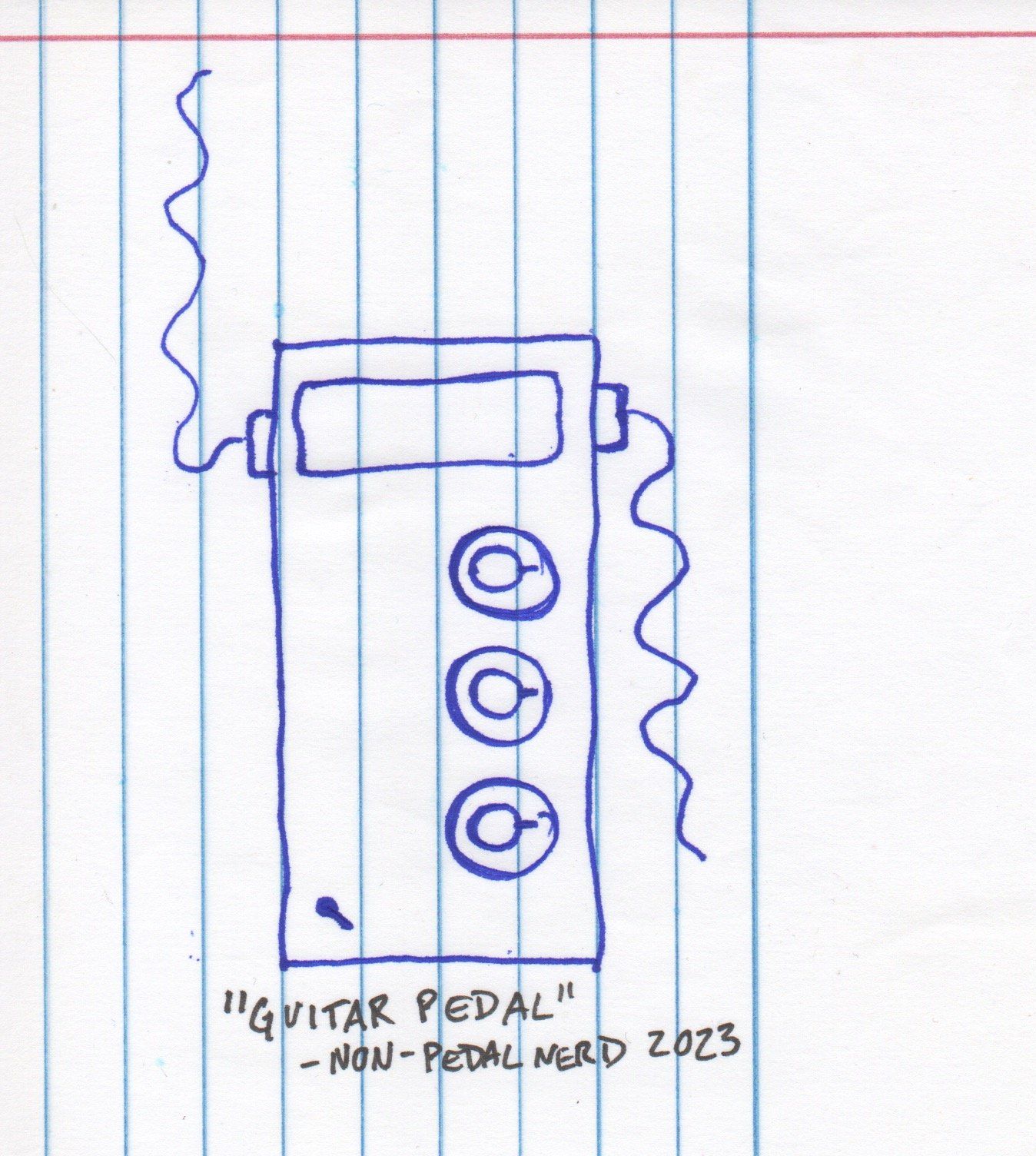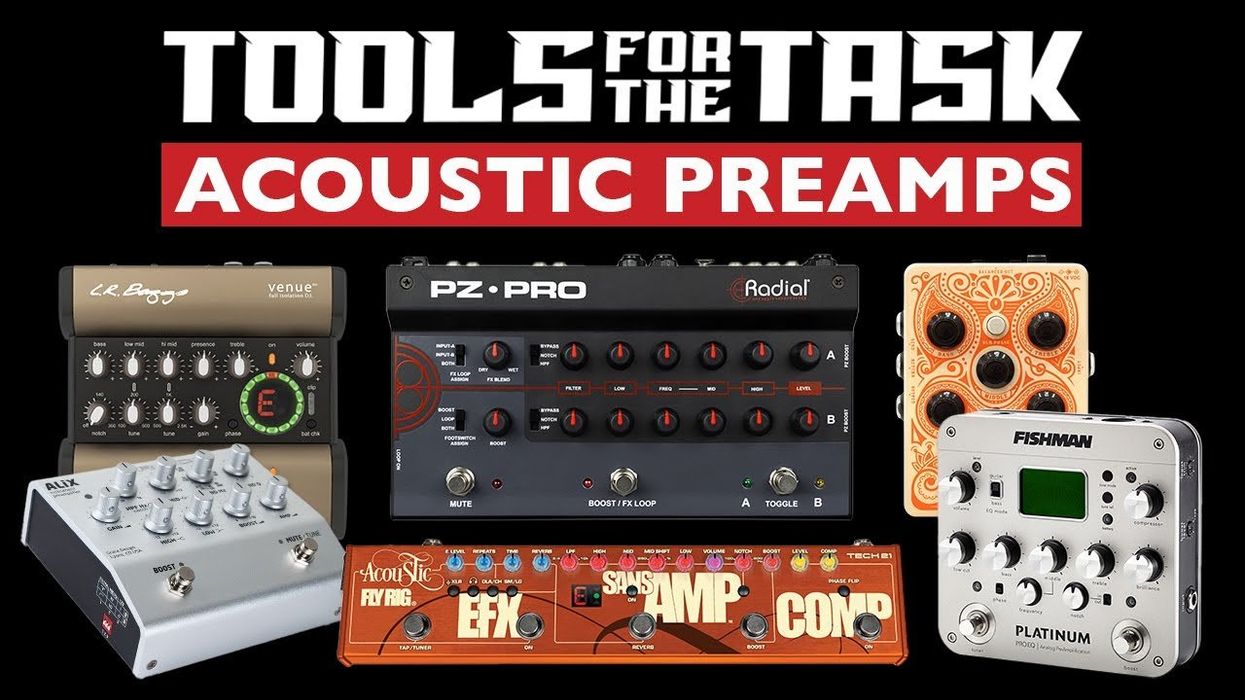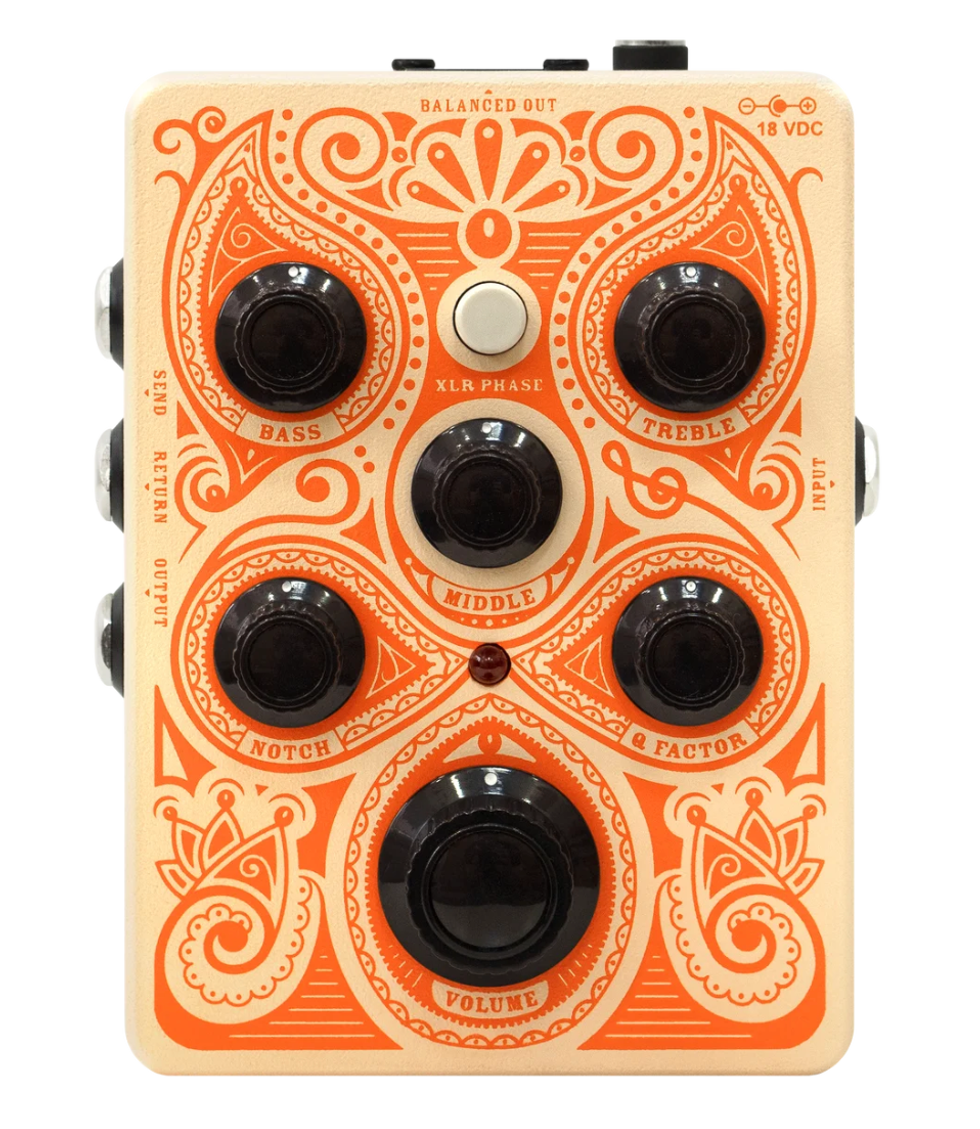
Our columnist’s tongue-in-cheek sketch of a “generic” effects pedal.
Pedal enthusiasts’ preferences when it comes to stompbox controls range from simple and easy to use to complex and highly customizable, and manufacturers just can’t please ’em all.
Stompboxes have been a part of musicians’ musical journeys for over 50 years. They’ve been packaged up in all different shapes, sizes, and colors. They’ve also featured a large array of different effects types, and allowed us to manipulate them with various control parameters. It’s these control parameters that are the focus of this article. Recently, I’ve been thinking, “How many knobs are too many, and how few knobs are too few?”
That question is one that sits in my mind alongside player remarks such as, “If it’s got more than three knobs, I won’t play it,” and, “I won’t buy a delay without tap tempo.” It’s these conflicting needs that can often lend to my own confliction when designing a pedal. I can often find myself in debate with colleagues about this exact thing. If we make something with a single knob, it’s streamlined and easy to use, and the perfect fit for some players’ needs. However, it’s also bereft of features and turns other players off due to lack of controls. If we make something with 10 knobs and multiple expression-capable controls, it’s feature-laden and offers great value while exciting the knob tweaker. However, it can feel alienating, confusing, and overwhelming for a lot of players. “I don’t want to need to bring up the manual every time I want to use it,” is another thing I hear a lot from players. That’s often followed by, “I just wanna plug it in and go!”
These sentiments are far from obscure or unreasonable, and they’re surely not in short supply. There’s no “correct” approach, whether it’s from the perspective of the companies that are manufacturing products, or the consumers that are purchasing products. There are vast and contrasting needs, and they seem to be ever-expanding. These contrasting needs have directly created what has become our diversity. That’s a great thing and there’s something out there for everyone.
The 1-knob versus 10-knob example helps to illustrate this topic while pointing out the diversity of options available to players. Perhaps this example is too extreme, though. Surely there must be a middle ground? There is! Oh, good. I was getting worried there for a second. I feel like if most people were asked to draw up a quick sketch of a guitar pedal, they would conjure up a rectangle with a footswitch and three to six knobs. I’m inclined to wonder if this is an unconscious act based on what they think the average pedal does have, or a conscious act towards what they think the average pedal should have. If we go down this thought experiment path, and use either reason, we get to the same conclusion on knob amount.“There are vast and contrasting needs, and they seem to be ever-expanding. These contrasting needs have directly created what has become our diversity.”
Indulge me for a minute. Let’s go with three to six as the ideal number of control parameters for a pedal. I’m inclined to believe that this range offers the most control flexibility for the user while avoiding confusion or the feeling of being overwhelmed. This, along with proper control labels and intuitive layout, can lead to a great experience for the majority of players. It can also be appealing to the largest demographic of potential customers: Give the user the right amount of control parameters so they’re not left wanting more nor feeling like a control is wasteful.
I can’t help but think back to a conversation that I had with a friend who beta tests pedals for a lot of companies in the industry. We were on the topic of a tone control knob for a particular pedal that I was designing. I had mentioned that I wasn’t sure about a particular aspect of the tone network, and was thinking about implementing an internal toggle to let the player choose. My friend replied, “Pick whichever is best for that pedal and go with that. I love the feeling of when I can tell that a company dialed something in perfectly for the pedal.”
There will never be a correct answer when it comes to the ideal amount of features on a pedal. That’s fine; players will naturally find themselves in the camp that is correct for them. You can see this every time you look at someone’s board. Some boards have six to 10 pedals and no pedal contains more than six knobs. Other boards have 12 to 20 pedals and most of the pedals have six-plus knobs.
Here’s something fun for the pedal lovers out there: Go up to a friend of yours that is familiar with pedals but is not super knowledgeable about them. Say to them, “Draw for me what you think of when you hear the words ‘guitar pedal.’” I’m interested to see how many knobs their drawing has.
- State of the Stomp: More Sounds from Fewer Pedals ›
- State of the Stomp: In Defense of Version 2 ›
- State of the Stomp: Living in Synth ›
- Discover the Power of J. Rockett Archer Select: Review - Premier Guitar ›
- Dreadbox Treminator: Synth Pedal Review ›
PG contributor Tom Butwin highlights 7 preamp options for your acoustic guitar. Wherever you’re looking to plug in your acoustic, these stomps have you covered with a wide range of functionality, sounds, and applications.
LR Baggs Venue DI Acoustic Guitar Preamp / DI / EQ / Tuner Pedal
Venue DI Acous Preamp/DI Pedal w/TunerRadial PZ-Pro 2-channel Acoustic Preamp Pedal
PZ-Pro 2-ch Acous Preamp Pedal/SwitcherGrace Design ALiX Acoustic Instrument Preamp / EQ / DI / Boost Pedal
ALiX Acous Inst Preamp - SilverBefore his headlining gig at Nashville’s Basement East, Donny B welcomed PG’s Chris Kies onstage to chat about his minimal-but-musical setup and explain the origins of “Donny.”
Bill Wyman's first album in 9 years, Drive My Car is out August 9.
Drive My Car will be available digitally, on CD and gatefold vinyl. Both CD and digital formats will feature two additional bonus tracks.
As a founding member and rhythm architect of The Rolling Stones, Bill became a household name, revered by fans and peers alike. With a career spanning over six decades, Wyman steps back into the spotlight with a fresh collection of songs showcasing his passion and talent. Five tracks, including the album’s title track are self-penned, a testament to Bill’s enduring songwriting talent. “It’s not something I do every day, but sometimes I just see a guitar in the corner of the room, pick it up to play around, and then something clicks into place,” he explains.
Bill Wyman - Drive My Car (Official Lyric Video)
Recorded at Wyman’s home studio, Drive My Car features a tight-knit group of long-time collaborators, including guitarist Terry Taylor and drummer Paul Beavis. “A bass player and a drummer are a team, you’re the rhythm section, the foundation of the whole thing,” Bill emphasizes. The album opens with a unique rendition of Bob Dylan’s 'Thunder On The Mountain,' combining elements from both Dylan's original and Wanda Jackson’s lively cover. “I’ve known Bob since the mid-‘60s," says Bill. "He used to take me and Brian Jones round the Greenwich Village clubs whenever we were in New York. We were very good friends for a while, he was a really nice guy.”
Another highlight is a cover of Taj Mahal’s 'Light Rain.' Bill recounts their long-standing friendship, which began in 1968 when Taj was invited to join The Stones Rock ‘n’ Roll Circus TV special. “He was fascinated that I was a member of the Royal Horticultural Society – we bonded over botany!” he recalls fondly.
Bill Wyman had a busy 2023. The oldest of the Rolling Stones (“They all talk about the war, but none of them remember it like I do!”), Bill mined his memories for vivid anecdotes of his wartime childhood and published them in an engrossing book, Billy In The Wars. At the same time, he was planning for the future, recording the songs for Drive My Car.
Reflecting on the album’s overall sound, Bill cites JJ Cale as a major influence. “I think the biggest influence on the album as a whole is JJ Cale, his laidback groove has always appealed to me. Friends I’ve played it to have said things like ‘it really sounds like you’, and that makes me happy. I’ve never tried to be anyone else - I’m Bill, basically.”
For more information, please visit billwyman.com.
Which guitarists are worthy of an artist-signature model? Rhett and Zach are on the case.
First off, let’s be thankful for this episode of Dipped In Tone. Rhett survived a close brush with a tornado while on the road in Arkansas, and returns to the pod to analyze all things signature guitars with Zach, who continues his dogged campaign to own a ridiculous number of Tube Screamers. (They didn’t plan their near-matching shirts.)
The conversation-starter is the new Jason Isbell “Red Eye,” a $21,999 collector’s version of the 1959 Gibson Les Paul that famously belonged to Ed King of Lynyrd Skynyrd. When King passed away in 2018, the story goes that Isbell wanted the guitar, but couldn’t afford it. Zach and Rhett explain how he accrued the capital to snag the axe, and the details behind the new artist edition.
But who gets signature guitars, anyway? Some iconic players, like John Frusciante—so easily identified with his Strats—still don’t have their own model. Is he being snubbed, or choosing to keep his name off a mass-produced guitar? Maybe some guitarists feel signatures are too corporate—which could also explain why Jack White has, so far, not lent his name to a model. (Though pedals are a different story.) And what about massively popular YouTube guitar stars and influencers—have they earned the right to be in the running for a signature 6-string?
Later, Zach and Rhett dig into the economics of siggys—how much do their namesakes actually earn from the sale of their personal brand?—and debate Slash’s bombshell move from Marshall to Magnatone.











